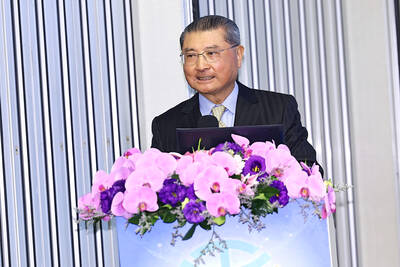The central bank’s board of directors last month rallied behind a policy rate hold and a 25 basis point increase in the lenders’ reserve requirement ratio that would exert the same tightening effect as rate hikes in cooling the housing market, according to the minutes of the board meeting released yesterday.
Although the consumer price index would rise above the 2 percent target rate this year, the central bank’s discount rate also reached 2 percent, the highest in 15 years, rendering further tightening unnecessary, a director said.
Export data up to May showed that only shipments of artificial intelligence-related products recorded solid growth, whereas the remaining product categories stayed in contraction, the director said.

Photo: Chen Mei-ying, Taipei Times
A further rate hike would add a financial burden to non-technology sectors as well as small and medium-sized enterprises, the director added.
Another director urged the monetary policymaker to continue monitoring consumer price trends given that housing rent has grown in an unabated fashion.
Another said that sturdy economic growth and elevated inflation merited rate hikes, but the increase in the reserve requirement ratio would have a similar tightening effect conducive to dampening inflation.
Another director voiced concerns that housing rent had continued rising, as had the cost of dining out.
“It is therefore important the central bank stand steadfast in its fight against inflation and show firm resolve in doing so,” the director said, calling the rate hold “acceptable” alongside the reserve requirement ratio adjustment.
Several directors threw their weight behind a measure to cut the loan-to-value cap from 70 percent to 60 percent on second mortgages in the six special municipalities and Hsinchu.
The package would help curb money flows to the real-estate market and drive up borrowing costs, they said.
One director pointed out that an imbalance between supply and demand, especially a lack of new and presale housing, had helped spur the housing boom.
The fall in construction financing and advances in home loans lent support to the observation, the director said.
While the reserve requirement ratio adjustment would help contain real-estate lending, monetary policy tools alone cannot end the imbalance, which requires means outside the central bank’s duty and capacity, the director said.
Another director said interest rate adjustments would help cool the housing market, but warned that such practices would have a harmful impact on private investment and consumption.
Steep rate hikes would be needed to meaningfully chill house prices, making the hawkish approach ill-advised, the director said.

When an apartment comes up for rent in Germany’s big cities, hundreds of prospective tenants often queue down the street to view it, but the acute shortage of affordable housing is getting scant attention ahead of today’s snap general election. “Housing is one of the main problems for people, but nobody talks about it, nobody takes it seriously,” said Andreas Ibel, president of Build Europe, an association representing housing developers. Migration and the sluggish economy top the list of voters’ concerns, but analysts say housing policy fails to break through as returns on investment take time to register, making the

‘SILVER LINING’: Although the news caused TSMC to fall on the local market, an analyst said that as tariffs are not set to go into effect until April, there is still time for negotiations US President Donald Trump on Tuesday said that he would likely impose tariffs on semiconductor, automobile and pharmaceutical imports of about 25 percent, with an announcement coming as soon as April 2 in a move that would represent a dramatic widening of the US leader’s trade war. “I probably will tell you that on April 2, but it’ll be in the neighborhood of 25 percent,” Trump told reporters at his Mar-a-Lago club when asked about his plan for auto tariffs. Asked about similar levies on pharmaceutical drugs and semiconductors, the president said that “it’ll be 25 percent and higher, and it’ll

CHIP BOOM: Revenue for the semiconductor industry is set to reach US$1 trillion by 2032, opening up opportunities for the chip pacakging and testing company, it said ASE Technology Holding Co (日月光投控), the world’s largest provider of outsourced semiconductor assembly and test (OSAT) services, yesterday launched a new advanced manufacturing facility in Penang, Malaysia, aiming to meet growing demand for emerging technologies such as generative artificial intelligence (AI) applications. The US$300 million facility is a critical step in expanding ASE’s global footprint, offering an alternative for customers from the US, Europe, Japan, South Korea and China to assemble and test chips outside of Taiwan amid efforts to diversify supply chains. The plant, the company’s fifth in Malaysia, is part of a strategic expansion plan that would more than triple

Taiwanese artificial intelligence (AI) server makers are expected to make major investments in Texas in May after US President Donald Trump’s first 100 days in office and amid his rising tariff threats, Taiwan Electrical and Electronic Manufacturers’ Association (TEEMA, 台灣電子電機公會) chairman Richard Lee (李詩欽) said yesterday. The association led a delegation of seven AI server manufacturers to Washington, as well as the US states of California, Texas and New Mexico, to discuss land and tax issues, as Taiwanese firms speed up their production plans in the US with many of them seeing Texas as their top option for investment, Lee said. The